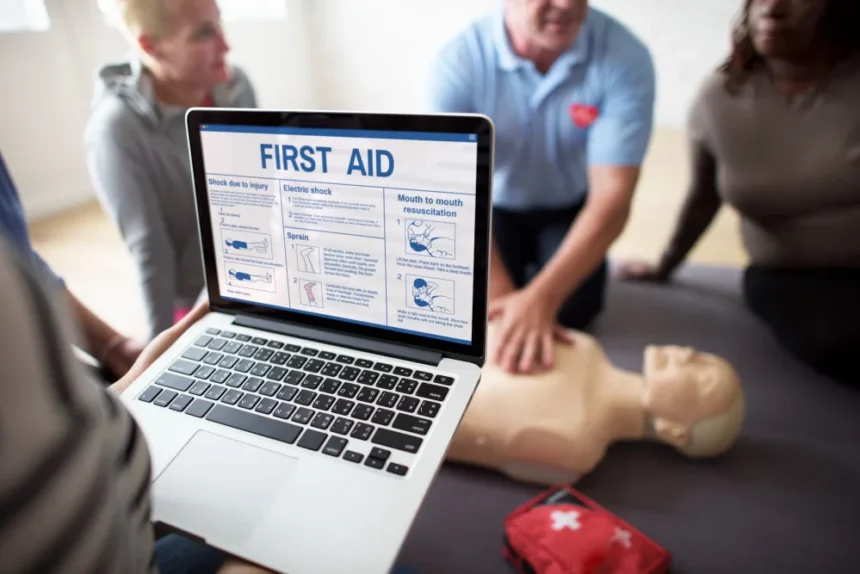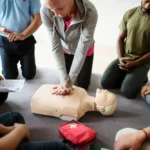Emergencies don’t come with a warning. A simple first aid skill can be the difference between life and death, between full recovery and permanent damage. That’s why first aid certification has become increasingly important not just for healthcare professionals, but for everyday individuals too.
But when you decide to get certified, one big question pops up: Should you choose online training, or attend in-person classes?
Both options have their merits, and selecting the right path depends on your lifestyle, learning preferences, and professional requirements. Let’s walk you through both choices in detail, so you can make an informed decision that suits your needs.
What is a First Aid Certification?
First aid certification equips you with essential knowledge and techniques to handle emergency medical situations, often before professional help arrives. You’ll learn life-saving procedures like CPR (Cardiopulmonary Resuscitation), wound care, fracture management, treating burns, handling allergic reactions, and responding to cardiac events.
Usually valid for 2–3 years, certifications ensure that individuals stay up-to-date with the latest best practices and guidelines, which are regularly updated by authorities in the United States.
What to Know About an Online First Aid Certification
Over the last decade, the rise of online education has made professional certifications, including first aid, more accessible than ever. Online courses allow you to learn essential theory and procedures at your convenience, often from the comfort of your home.
Advantages of Online First Aid Certification
An online first aid certification has multiple benefits for those who pursue it. Here’s an overview of these benefits that also explain its reliability:
Unparalleled Flexibility
Online certification lets you study around your existing commitments, work, family, travel, without rearranging your life. You can pause, resume, or repeat modules based on your own schedule.
Self-Paced Learning Environment
Every learner is different. Some grasp concepts quickly; others prefer more time. Online platforms cater to both, allowing you to absorb information at a pace that ensures better understanding.
Greater Accessibility
Living in a rural town? Travelling often? Online courses erase geographical barriers, offering access to training irrespective of where you are.
Cost-Effective
Generally, online programs are more affordable compared to in-person classes, saving costs on travel, printed materials, and even course fees.
Limitations of Online First Aid Certification
While many individuals incur the benefits of an online first aid certification, it has its share of limitations, too. Here’s what these challenges look like:
Lack of Hands-On Experience
Watching a video about CPR and physically performing it are two very different things. Online formats often lack the practical element necessary to fully master life-saving techniques.
Employer Acceptance May Vary
Some organizations, especially in healthcare, education, or security, require certifications earned through accredited in-person programs. Always verify your employer’s requirements before enrolling.
Limited Immediate Feedback
If you incorrectly perform a chest compression or a rescue breath, an instructor isn’t there to immediately correct you. This can leave gaps in your practical readiness during actual emergencies.
An Overview of the In-Person First Aid Certification
In-person training remains the gold standard for mastering first aid skills. By physically attending a class led by certified instructors, you benefit from real-world simulations, peer interactions, and direct mentorship.
Advantages of In-Person First Aid Certification
An in-person first aid certification is a traditional way to teach individuals the basics of first aid and other healthcare settings. Its benefits are:
Hands-On Practical Training
Using mannequins, first aid kits, and AED machines during drills helps you build muscle memory, a crucial component for fast, correct reactions during emergencies.
Immediate Feedback for Skill Improvement
If you don’t press hard enough during CPR or misplace your hands during chest compressions, instructors spot these mistakes immediately and help you adjust.
Realistic Emergency Simulations
In-person courses often use scenarios to simulate real-life emergencies, training you to stay calm, prioritize actions, and lead or assist during a crisis.
Widely Recognized Certification
Courses conducted by accredited providers like the Red Cross or AHA carry universal credibility. Employers in sensitive fields often require proof of hands-on training.
Limitations of In-Person First Aid Certification
In-person first aid certification has several limitations which makes individuals choose an online course instead of going the traditional way. The limitations are:
Rigid Scheduling
Unlike online learning, you need to attend classes at specific times. Missing a session may require you to reschedule or even retake the course.
Time and Travel Commitments
Getting to the training location and dedicating several hours, or days, can be challenging for busy professionals or those without nearby centers.
Higher Costs
In-person courses often come with higher fees due to equipment use, facility charges, and instructor fees.
Making the Right Choice: Online or In-Person?
A report by Harvard Health Publishing suggests that out of 65% of Americans who have received CPR training, only 18% are up-to-date with the latest data. This highlights an important reality: doing online or offline first aid courses that excel at delivering knowledge. Their practical training significantly boosts the quality and effectiveness of emergency response.
When weighing your options, think carefully about your personal and professional goals. Here’s a comparative glance at both certifications in detail.
| Criteria | Online First Aid Certification | In-Person First Aid Certification |
| Flexibility | You need adaptable scheduling | You can commit to fixed class times |
| Hands-On Practice | You’re comfortable with minimal physical practice | You want real-world practice and feedback |
| Employer Requirements | Your employer accepts online certification | Your employer demands accredited, physical certification |
| Cost | You prefer a budget-friendly option | You’re willing to pay more for robust training |
| Learning Style | You learn well independently | You benefit from direct interaction and demonstrations |
Choose a First Aid Certification that Suits Your Needs
Choosing between online and in-person first aid certification is ultimately about what suits you best. If you’re seeking theoretical knowledge quickly and conveniently, online certification offers an excellent path. But if you want to physically practice skills, build true confidence, and ensure the highest quality of care during emergencies, in-person certification is the better choice.
Regardless of the format you choose, earning your first aid certification is an invaluable investment, not just for yourself, but for your family, colleagues, and community. Because when emergencies happen, being prepared is mandatory.










